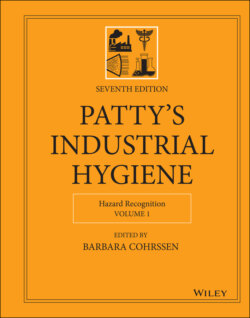Читать книгу Patty's Industrial Hygiene, Hazard Recognition - Группа авторов - Страница 16
2.1 The Early 1900s
ОглавлениеDuring the early history of industrial development, a lack of knowledge of the effects of health stressors associated with industrial operations and how these could be controlled, with the concomitant substantial exposures to toxic materials in many places of work, led to serious episodes of illness, disease, and death among workers.
It was not until around the beginning of the twentieth century that specific attention began to be devoted to the preventive aspects of occupational illnesses. Early progress in Great Britain was made with dusts being a focus of such occupational and industrial hygiene efforts, as featured in the text Dangerous Trades by Oliver in 1902 (5). The 1916 text in the US edited by Kober and Hanson entitled Diseases of Occupational and Vocational Hygiene provided a contemporary view of the state of industrial hygiene in the United States at the time (6).
In the early 1900s, the major thrust in the control of workplace health stressors was directed toward those areas in industry having massive exposures to highly toxic materials. The professional talents of engineers, chemists, physicians, physicists, and statisticians were largely used in these efforts.
During this time, scientists and practitioners including engineers, chemists, and physicists, began to apply their knowledge and skills toward the development of methods and procedures for identifying, measuring, and controlling exposures to harmful airborne dusts and other chemical agents in workplaces. A general example is the high incidence of silicosis and silicotuberculosis that existed a century ago among workers in hard rock mines, the granite industry, and in tunneling operations, wherever the dust had a high free silica content. During this early period, the major effort on behalf of workers' health was to apply the knowledge at hand, which related primarily to the recognition and treatment of occupational illnesses.
There were several early efforts at organizing the profession in the United States during this time. The American Public Health Association (APHA) started a section on Industrial Hygiene in 1914, the US Public Health Service (USPHS) organized a division of Industrial Hygiene and Sanitation in 1915, and a group of occupational physicians formed the American Association of Industrial Physicians and Surgeons in 1916. The Journal of Industrial Hygiene in the United States was initially published in 1919, and the Harvard Schools of Public Health and Engineering established a program in 1927 for industrial sanitation that was important to the development of the industrial hygiene profession (7).
Choosing means for assessing levels of agents in air early in the twentieth century is a case in point in the need for advancement in methods and technologies to improve the practice of exposure assessment and industrial hygiene. The first standard method to measure dust in the work environment was developed in 1916 (8),(9). As a more specific example, in 1918, the first measurement of worker exposure to asbestos was recorded in the industrial hygiene scientific literature by Smyth . It was recognized at this time that various kinds of dust exist, and the harmfulness of the dust depends on both the nature of the dust as well as the amount, with the results of Smyth referenced by Greenburg in 1921 (13). The Greenburg Smith impinger dust‐sampling instrument was introduced in 1922 (14). Other instruments, such as the konimeter, Owens Jet dust counter, electrostatic precipitator, and evacuated containers, also came into use during this period. By 1923, the movement for the betterment of industrial conditions had taken on an international character. In the United States, groundbreaking occupational disease texts were published by Dr. Alice Hamilton in 1925 (15) and 1934 (16). Still, beyond the early pioneers such as Dr. Hamilton, specific knowledge of the hazards and industrial disease risks prior to 1930, as perhaps best described by Greenberg, was convoluted and unclear (17).
